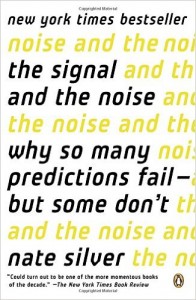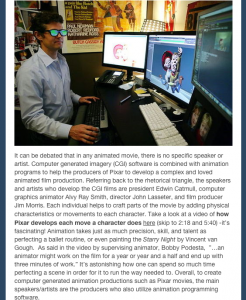 A funny thing happened as my students were wrapping up their narrative journalism papers a couple weeks ago on the shiny new Chromebooks I’d reserved for the assignment. As I was reviewing a few formatting details with them, it suddenly dawned on me that my deadline for a hard copy of the paper–the end of the hour–was physically impossible. There is no printer attached to our Chromebook carts.
A funny thing happened as my students were wrapping up their narrative journalism papers a couple weeks ago on the shiny new Chromebooks I’d reserved for the assignment. As I was reviewing a few formatting details with them, it suddenly dawned on me that my deadline for a hard copy of the paper–the end of the hour–was physically impossible. There is no printer attached to our Chromebook carts.
After panicking momentarily and shrugging off the realization in front of the kids, I remembered a lovely feature of Turnitin.com. I told my students to submit their papers to Turnitin as usual, and that no hard copy would be necessary. In place of the normal written feedback on their papers and on an attached district rubric, my juniors would be getting three minutes of my silky-smooth voice walking them through their writing, using Turnitin’s audio feedback feature.
“Pass me the mic”
You should know that there are lots of educational tools out there for providing audio feedback to students. If all else fails, the phone app Voxer will let you share voice memos with anyone who “friends” you in the application (which can be done without revealing your actual cell number).
If getting ahold of a recording method isn’t a problem but the huge shift in how you provide feedback is, then I’d ask you to consider why conferencing remains the most impactful method of improving student writing. Kids listen when you talk to them one-on-one. Even the reluctant writers.
In fact, The Writing Center at the University of Wisconsin-Madison suggests that the best feedback for student writing “mirrors conversation with student-writers.” Though speaking your thoughts aloud falls one voice short of a “dialogue,” it certainly allows you to imitate the key elements of a good writing conference: your supportive tone of voice, the context for your criticisms, and clear guidance for how to move forward.
Talk Them Up
 Let’s consider briefly what written feedback tends to look like when you have 100 essays to grade.
Let’s consider briefly what written feedback tends to look like when you have 100 essays to grade.
You can use a coded system that reduces full ideas to symbols (that your lowest readers will ignore), you can write slightly longer phrases in the tiny margins (which your kids may not be able to read), or you can attempt to provide a full-bodied paragraph of feedback at the end of each essay (which will eventually give you carpal-tunnel syndrome and break your spirit completely…oh, and many of your lowest writers won’t bother to read it.).
I want to suggest to you that audio feedback solves ALL of these problems. In place of countless marks and comments about a student’s grammar, for example, you can now make one supportive, constructive observation. Here’s one hypothetical piece of feedback about possessives:
“One area you should be focused on in future essays is knowing when to use the possessive versus when something is plural. You confuse the two twice in your first paragraph. You use some really interesting syntax throughout the piece, so this small punctuation issue is holding back the power of how great the rest of your writing is.”
See how I softened the blow of the feedback by connecting it to a reminder of something done well? That’s a lot harder to do in the one-inch margins of the essay itself.
What’s more, you can tell them a sort of “story” about their writing. In place of fragmented ideas like “weak intro” or “explain this better” you can walk them through a coherent examination of their paper’s successes and struggles:
“Notice how your thesis is ambiguous about character X? Now look at how much your second body paragraph struggles to make a clear point about how X behaves in the final scene. Your vagueness in the introduction is keeping you from maintaining a clear focus in your body paragraphs.”
And really, that’s the big advantage to audio feedback: isolated, pragmatic written comments peppering the margins are transformed into a comprehensive walkthrough of their writing. If your department uses a standardized rubric, the structure of your feedback is even provided for you.
Students Want to Listen
I’ve found that even my reluctant writers and apathetic learners are intrigued by the idea of a few minutes of audio just for them. If you keep the tone friendly, they’re especially interested. It feels personal–like you’ve set aside time to speak just to them.
If you aren’t so sure your kids will be as eager about it, save the score of their paper for somewhere at the end of the audio file–make them listen to what you have to say in order to arrive at their score. I promise you won’t have to provide such enticement the second time around if your audio is done right–they’ll be happy to listen.

Michael Ziegler (@ZigThinks) is a Content Area Leader and teacher at Novi High School. This is his 15th year in the classroom. He teaches 11th Grade English and IB Theory of Knowledge. He also coaches JV Girls Soccer and has spent time as a Creative Writing Club sponsor, Poetry Slam team coach, AdvancEd Chair, and Boys JV Soccer Coach. He did his undergraduate work at the University of Michigan, majoring in English, and earned his Masters in Administration from Michigan State University.

 For the past several years I have been having conversations with different people in my district about having our students create digital portfolios. This effort is finally gaining some ground, though the way has been painfully slow from my perspective.
For the past several years I have been having conversations with different people in my district about having our students create digital portfolios. This effort is finally gaining some ground, though the way has been painfully slow from my perspective. This project has also inspired students to create other sites about personal interests. Seeing the application of this skill in their personal life is exactly the kind of transfer we hope for, and the kind of artifact that students can highlight down the road.
This project has also inspired students to create other sites about personal interests. Seeing the application of this skill in their personal life is exactly the kind of transfer we hope for, and the kind of artifact that students can highlight down the road. Beth Rogers is a fifth grade teacher for
Beth Rogers is a fifth grade teacher for  Each year I have my students engage in a variety of online writing experiences: blogging, Google documents, websites, and presentations. At this point in the year, I find that there are two sides to online writing, and finding a way to balance them is my greatest challenge.
Each year I have my students engage in a variety of online writing experiences: blogging, Google documents, websites, and presentations. At this point in the year, I find that there are two sides to online writing, and finding a way to balance them is my greatest challenge. 5th grade classes in Maine and we are participating in the
5th grade classes in Maine and we are participating in the  I think it’s safe to say that there’s a bit more mathematical calculation in your normal English classroom pedagogy than there was, say, five years ago.
I think it’s safe to say that there’s a bit more mathematical calculation in your normal English classroom pedagogy than there was, say, five years ago.  The funny thing about data, though, is that numbers aren’t as clear and objective as all those charts and bar graphs would have us believe. If you don’t want to take an English teacher’s word for that, get ahold of Nate Silver’s
The funny thing about data, though, is that numbers aren’t as clear and objective as all those charts and bar graphs would have us believe. If you don’t want to take an English teacher’s word for that, get ahold of Nate Silver’s  Description:
Description: All sessions are 1:00pm – 4:15 pm
All sessions are 1:00pm – 4:15 pm Several years ago, I went in search of an audience for my students, although at the time I didn’t know that was what I was up to. I’d seen enough student writing to know I wasn’t doing something right in my instruction. My students were smart, interesting and capable of all manner of argument, but their writing didn’t reflect that. However, they were willing to risk suspension by breaking through the district’s internet firewall to reach sites like Myspace and Facebook where they wrote (Wrote!) about things they cared about in ways that reflected their personalities. This was what I was looking for. So I started a website where my students and I could build on the conversations we were having in class, and they could write in the same way they wrote on social media sites. I envisioned a free flowing forum of ideas and enthusiasm, a place for authentic voices like I’d seen on Facebook and Myspace, like I’d heard in my classroom. Yeah, I was wrong.
Several years ago, I went in search of an audience for my students, although at the time I didn’t know that was what I was up to. I’d seen enough student writing to know I wasn’t doing something right in my instruction. My students were smart, interesting and capable of all manner of argument, but their writing didn’t reflect that. However, they were willing to risk suspension by breaking through the district’s internet firewall to reach sites like Myspace and Facebook where they wrote (Wrote!) about things they cared about in ways that reflected their personalities. This was what I was looking for. So I started a website where my students and I could build on the conversations we were having in class, and they could write in the same way they wrote on social media sites. I envisioned a free flowing forum of ideas and enthusiasm, a place for authentic voices like I’d seen on Facebook and Myspace, like I’d heard in my classroom. Yeah, I was wrong. This all happened at the turn of the century, but the idea of 21st century literacy wasn’t on my radar. I wasn’t thinking about how drastically teaching reading and writing was going to be impacted by the World Wide Web. I just wanted to be in on what was happening. Though my first failures did send me in a new direction. My students were using platforms like MySpace to say things about themselves, to give their opinions, and to challenge each others’ ideas. It was entirely social, but what they were doing was writing, sometimes with letters and words, sometimes with images. But it’s all text, and that’s what drew me in. So I tried again.
This all happened at the turn of the century, but the idea of 21st century literacy wasn’t on my radar. I wasn’t thinking about how drastically teaching reading and writing was going to be impacted by the World Wide Web. I just wanted to be in on what was happening. Though my first failures did send me in a new direction. My students were using platforms like MySpace to say things about themselves, to give their opinions, and to challenge each others’ ideas. It was entirely social, but what they were doing was writing, sometimes with letters and words, sometimes with images. But it’s all text, and that’s what drew me in. So I tried again. the way my students wrote. Their voices faded. Those few times I did manage to spark something good–thoughtful, honest writing with authentic voices about a text we were looking at–then their writing became self supporting. Students abandoned me as audience and wrote for each other, fed off each other and it had very little–actually nothing–to do with me. In fact, I was very careful not to enter into the conversation because as soon as I said anything, their writing changed course and was directed at replicating the thing I’d praised. The writing even changed when students knew that I was lurking but not writing anything. Many of them would lose the nerve to be the writers they really were. It didn’t matter that I told them that their audience was each other; my mere virtual presence changed how they wrote. When I became their audience, they tried to write like students. But when their audience was other students, they wrote like writers. They had more confidence, took risks, and tried to engage the each other. In short, they did what writers do.
the way my students wrote. Their voices faded. Those few times I did manage to spark something good–thoughtful, honest writing with authentic voices about a text we were looking at–then their writing became self supporting. Students abandoned me as audience and wrote for each other, fed off each other and it had very little–actually nothing–to do with me. In fact, I was very careful not to enter into the conversation because as soon as I said anything, their writing changed course and was directed at replicating the thing I’d praised. The writing even changed when students knew that I was lurking but not writing anything. Many of them would lose the nerve to be the writers they really were. It didn’t matter that I told them that their audience was each other; my mere virtual presence changed how they wrote. When I became their audience, they tried to write like students. But when their audience was other students, they wrote like writers. They had more confidence, took risks, and tried to engage the each other. In short, they did what writers do.

 Rick Kreinbring teaches English at Avondale High School in Auburn Hills, Michigan. His current assignments include teaching AP Language and Composition and AP Literature and Composition. He is a member of a
Rick Kreinbring teaches English at Avondale High School in Auburn Hills, Michigan. His current assignments include teaching AP Language and Composition and AP Literature and Composition. He is a member of a  Engagement–what does it mean? How do we foster engagement in our classrooms? Like Marcia, I see learner identity as a key part of engaging learners. The idea of mindset playing a role in how a learner engages is well
Engagement–what does it mean? How do we foster engagement in our classrooms? Like Marcia, I see learner identity as a key part of engaging learners. The idea of mindset playing a role in how a learner engages is well  Not long ago, I came across Staci Hurst’s
Not long ago, I came across Staci Hurst’s 
 Susan Wilson-Golab joined Oakland Schools in 2010 following 22 years of in the field 6-12 experience across two different states and rural, suburban, and urban contexts. Her research and practice focus heavily on the evolving definition of literacy, developmental learning progressions, and formative assessment. At the district level, Susan has served as classroom teacher, Literacy Specialist, and ELA Curriculum Coordinator. These experiences and study helped Susan in her role as Project Leader for developing a
Susan Wilson-Golab joined Oakland Schools in 2010 following 22 years of in the field 6-12 experience across two different states and rural, suburban, and urban contexts. Her research and practice focus heavily on the evolving definition of literacy, developmental learning progressions, and formative assessment. At the district level, Susan has served as classroom teacher, Literacy Specialist, and ELA Curriculum Coordinator. These experiences and study helped Susan in her role as Project Leader for developing a  As teachers, we all have students who are compliant and willful, who will readily produce whatever output we ask or demand of them to please the teacher or earn a desired grade. There is no question that narrative and non-fiction writing are critical skills that must be taught explicitly at all levels every year. Increasingly, however, in an era of online publishing and digital content production on social media sites, students need to know that whatever they are asked to generate will have a meaningful audience and make a difference to someone. In 2014, kids have never known a world where they haven’t been able to reach out around the globe in seconds and make an impact with words, pictures, and video on Instagram, Twitter, or Facebook. The ability to publish at the click of a button has provided a liberating opportunity for students to receive swift feedback and effectively measure the impact their writing has on their intended audience.
As teachers, we all have students who are compliant and willful, who will readily produce whatever output we ask or demand of them to please the teacher or earn a desired grade. There is no question that narrative and non-fiction writing are critical skills that must be taught explicitly at all levels every year. Increasingly, however, in an era of online publishing and digital content production on social media sites, students need to know that whatever they are asked to generate will have a meaningful audience and make a difference to someone. In 2014, kids have never known a world where they haven’t been able to reach out around the globe in seconds and make an impact with words, pictures, and video on Instagram, Twitter, or Facebook. The ability to publish at the click of a button has provided a liberating opportunity for students to receive swift feedback and effectively measure the impact their writing has on their intended audience. We all know that technology tools are constantly evolving and changing. What will remain immutable, however, is the architecture of story–problem, solution, characters, and setting. As long as we enable our students to make choices about the multi-modal output they would like to try, they will be motivated to learn the fundamental writing skills they need to grow and develop as writers. Students are empowered by both multi-media tools and the allure of a wider audience. Their work will have meaning for the maximum number of people possible, as it should. Kids care about writing and creating when they know people pay attention to and care about their work, that their writerly voices will be heard.
We all know that technology tools are constantly evolving and changing. What will remain immutable, however, is the architecture of story–problem, solution, characters, and setting. As long as we enable our students to make choices about the multi-modal output they would like to try, they will be motivated to learn the fundamental writing skills they need to grow and develop as writers. Students are empowered by both multi-media tools and the allure of a wider audience. Their work will have meaning for the maximum number of people possible, as it should. Kids care about writing and creating when they know people pay attention to and care about their work, that their writerly voices will be heard.
 Different disciplines define “audience” using other words, but it all comes down to the perception and experience of the end user. All products, all successful products, are designed with the user in mind, as determined by product testing or a focus group. Art and music, while often very personal, succeed when they “find and audience.” Sketching, journaling, and playing random chords because they please you is fine because you are the only audience. But if you want to find out if you’re good, however that’s defined, you need an audience.
Different disciplines define “audience” using other words, but it all comes down to the perception and experience of the end user. All products, all successful products, are designed with the user in mind, as determined by product testing or a focus group. Art and music, while often very personal, succeed when they “find and audience.” Sketching, journaling, and playing random chords because they please you is fine because you are the only audience. But if you want to find out if you’re good, however that’s defined, you need an audience. In the past couple of years, I have been putting more and more emphasis on the importance of audience in writing. I talk with my students about who their audience is, its characteristics, what moves it, and recently, we talked about what might delight the audience. The mantra “when you write for everyone, you write for no one” echoes through my room as we try to imagine that one person we’re trying to reach. (I know who it is for this piece.)
In the past couple of years, I have been putting more and more emphasis on the importance of audience in writing. I talk with my students about who their audience is, its characteristics, what moves it, and recently, we talked about what might delight the audience. The mantra “when you write for everyone, you write for no one” echoes through my room as we try to imagine that one person we’re trying to reach. (I know who it is for this piece.)